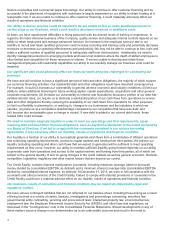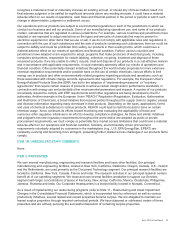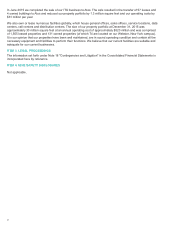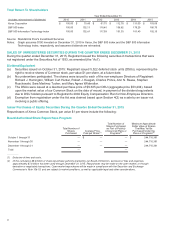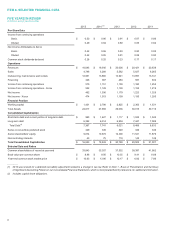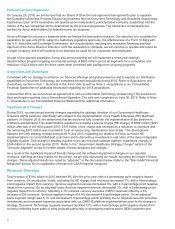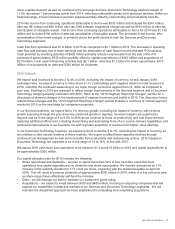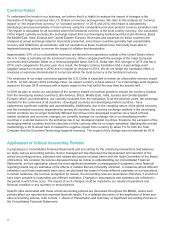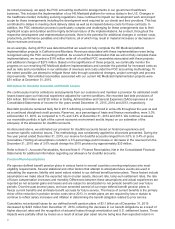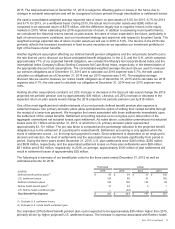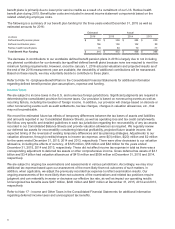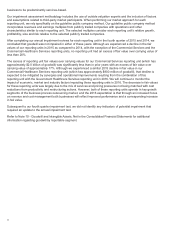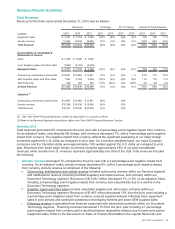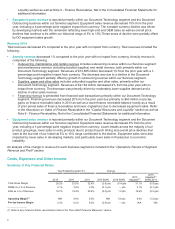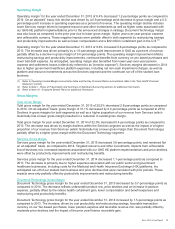Xerox 2015 Annual Report Download - page 46
Download and view the complete annual report
Please find page 46 of the 2015 Xerox annual report below. You can navigate through the pages in the report by either clicking on the pages listed below, or by using the keyword search tool below to find specific information within the annual report.Currency Impact
To understand the trends in our business, we believe that it is helpful to analyze the impact of changes in the
translation of foreign currencies into U.S. Dollars on revenue and expenses. We refer to this analysis as “currency
impact” or “the impact from currency” or "constant currency". In 2015 and 2014, this impact is calculated by
translating current period activity in local currency using the comparable prior year period's currency translation rate.
This impact is calculated for all countries where the functional currency is the local country currency. Our calculation
of this impact currently excludes the exchange impact from our developing market countries (Latin America, Brazil,
the Middle East, India, Eurasia and Central-Eastern Europe). Revenues and expenses for these countries are
analyzed at actual exchange rates for all periods presented, since these countries generally had unpredictable
currency and inflationary environments, and our operations in these countries have historically been able to
implement pricing actions to recover the impact of inflation and devaluation.
Approximately 30% of our consolidated revenues are derived from operations outside of the United States where
the U.S. Dollar is normally not the functional currency. When compared with the average of the major European
currencies and Canadian Dollar on a revenue-weighted basis, the U.S. Dollar was 16% stronger in 2015 and flat in
2014, each compared to the prior year. As a result, the foreign currency translation had a 4-percentage point
negative impact on revenue in 2015 and no impact on revenue in 2014. We do not hedge the translation effect of
revenues or expenses denominated in currencies where the local currency is the functional currency.
The weakness of our major currencies against the U.S. Dollar is expected to remain an unfavorable revenue impact
in 2016. At mid January 2016 exchange rates, we expect currency to have about a 1 to 2 percentage point negative
impact on full-year 2016 revenues with a higher impact in the first half of the year than the second half.
In 2016 we plan to revise our calculation of the currency impact on revenue growth to include the currency impacts
from the developing market countries (Latin America, Brazil, Middle East, India, Eurasia and Central-Eastern
Europe), which, as noted above, are currently excluded from the calculation. Over the past few years, the exchange
markets for the currencies of all countries - developed countries and developing market countries - have
experienced significant volatility and unpredictability. Additionally, due to the changing nature of the global economy
and the increased economic dependencies among all countries, the currency exchange markets in the developing
market countries are no longer materially different from those in the developed countries. As a result of these
market dynamics and economic changes, we currently manage our exchange risk in our developing market
countries in a similar manner to the exchange risk in our developed market countries; therefore, the exclusion of the
developing market countries from the calculation of the currency effect is no longer warranted. Applying this revised
methodology in 2015 would have increased the negative impact from currency by about 1% for both the Total
Company and the Document Technology segment revenues. The impact of this change was not material for 2014.
Application of Critical Accounting Policies
In preparing our Consolidated Financial Statements and accounting for the underlying transactions and balances,
we apply various accounting policies. Senior management has discussed the development and selection of the
critical accounting policies, estimates and related disclosures included herein with the Audit Committee of the Board
of Directors. We consider the policies discussed below as critical to understanding our Consolidated Financial
Statements, as their application places the most significant demands on management's judgment, since financial
reporting results rely on estimates of the effects of matters that are inherently uncertain. In instances where different
estimates could have reasonably been used, we disclosed the impact of these different estimates on our operations.
In certain instances, like revenue recognition for leases, the accounting rules are prescriptive; therefore, it would not
have been possible to reasonably use different estimates. Changes in assumptions and estimates are reflected in
the period in which they occur. The impact of such changes could be material to our results of operations and
financial condition in any quarterly or annual period.
Specific risks associated with these critical accounting policies are discussed throughout the MD&A, where such
policies affect our reported and expected financial results. For a detailed discussion of the application of these and
other accounting policies, refer to Note 1 - Basis of Presentation and Summary of Significant Accounting Policies in
the Consolidated Financial Statements.
29


